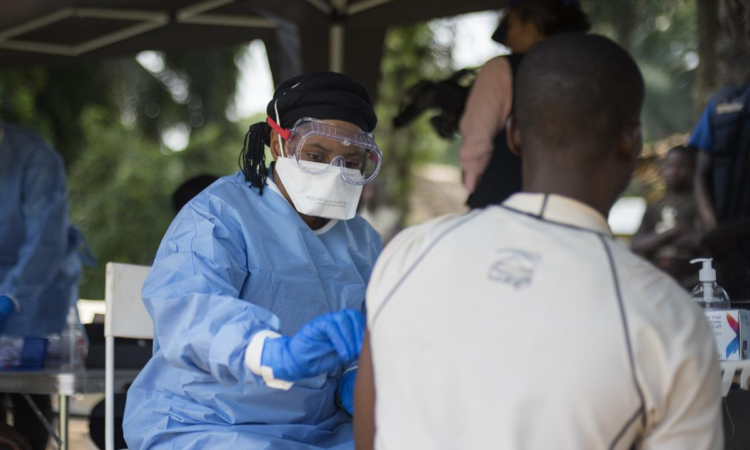
Ebola virus disease (EVD or Ebola) is a rare but severe illness in humans. It is often fatal.
People get infected with Ebola by touching:
Ebola enters the body through cuts in the skin or when touching one’s eyes, nose or mouth.
Early symptoms include fever, fatigue and headache.
Some types of Ebola can be prevented with vaccines and treated with medicines.
Ebola first appeared in 1976 in 2 simultaneous outbreaks, one in what is now Nzara, South Sudan, and the other in Yambuku, Democratic Republic of the Congo. The latter occurred in a village near the Ebola River, from which the disease takes its name.
The virus family Filoviridae includes 3 genera: Cuevavirus, Marburgvirus, and Ebolavirus. Within the genus Ebolavirus, 6 species have been identified: Zaire, Bundibugyo, Sudan, Taï Forest, Reston and Bombali.
It is thought that fruit bats of the Pteropodidae family are natural Ebola virus hosts. Ebola is introduced into the human population through close contact with the blood, secretions, organs or other bodily fluids of infected animals such as fruit bats, chimpanzees, gorillas, monkeys, forest antelope or porcupines found ill or dead or in the rainforest.
Ebola then spreads through human-to-human transmission via direct contact (through broken skin or mucous membranes) with:
Health-care workers have frequently been infected while treating patients with suspected or confirmed Ebola. This occurs through close contact with patients when infection control precautions are not strictly practiced.
Burial ceremonies that involve direct contact with the body of the deceased can also contribute to the transmission of Ebola.
People remain infectious as long as their blood contains the virus. After recovery, there is the possibility of sexual transmission, which can be reduced with support and information for survivors.
Pregnant women who get acute Ebola and recover from the disease may still carry the virus in breastmilk, or in pregnancy related fluids and tissues.
For more, read the guidelines on the management of pregnancy and breastfeeding in Ebola.
The symptoms of Ebola infection can be sudden and include fever, fatigue, muscle pain, headache and sore throat. These are followed by vomiting, diarrhoea, rash, and internal and external bleeding.
The time from when someone gets infected to having symptoms is usually from 2 to 21 days. A person with Ebola can only spread the disease once they have symptoms. People can spread Ebola for as long as their body contains the virus, even after they have died.
After recovering from Ebola, some people may have symptoms for two years or longer. These symptoms can include:
People should speak to a health-care professional if they have:
It can be difficult to clinically distinguish Ebola virus disease from other infectious diseases such as malaria, typhoid fever and meningitis. Many symptoms of pregnancy and Ebola disease are also quite similar. Because of risks to the pregnancy and themselves, pregnant women should ideally be tested rapidly if Ebola is suspected.
Confirmation that symptoms are caused by Ebola virus infection are made using the following diagnostic methods:
Diagnostic tests evaluated through the WHO emergency use assessment and listing process can be seen here.
People with symptoms of Ebola should get medical care immediately. Early care improves a person’s chances of surviving Ebola.
Treatment includes oral or intravenous fluids and medicines provided in the hospital.
It is not safe to care for people with Ebola at home, because the person may make other people sick. At home, they will not receive the same level of care they can get from professionals.
There is an effective vaccine for the Zaire type of Ebola, which is mostly found in Guinea and the Democratic Republic of the Congo. It is treated with antibodies. These antibody medicines are given intravenously and increase the chances of survival.
Research is ongoing to find vaccines and treatments for other types of Ebola.
For all types of Ebola, supportive treatments save lives and include the following:
WHO has guidance that outlines the optimized supportive care Ebola patients should receive, from the relevant tests to administer, to managing pain, nutrition and co-infections (such as malaria), and other approaches that put the patient on the best path to recovery.
In the 2018–2020 Ebola outbreak in the Democratic Republic of the Congo, the first-ever multi-drug randomized control trial was conducted to evaluate the effectiveness and safety of drugs used in the treatment of Ebola patients. WHO has living guidance on the recommended treatments and approaches.
More information on Ebola clinical management
People can protect themselves from getting Ebola by:
The Ervebo vaccine has been shown to be effective in protecting people from the species Zaire ebolavirus and is recommended by the Strategic Advisory Group of Experts on Immunization as part of a broader set of Ebola outbreak response tools.
WHO prequalifies Ebola vaccine, paving the way for its use in high-risk countries
Good outbreak control relies on applying a package of interventions, including case management, surveillance and contact tracing, a good laboratory service, safe burials and social mobilisation. Community engagement is key to successfully controlling outbreaks. Raising awareness of risk factors for Ebola infection and protective measures (including vaccination) that individuals can take is an effective way to reduce human transmission. Risk reduction messaging should focus on several factors:
Health-care workers should always take standard precautions when caring for patients, regardless of their presumed diagnosis. These include basic hand hygiene, respiratory hygiene, use of personal protective equipment (to block splashes or other contact with infected materials), safe injection practices and safe burial practices.
Health-care workers caring for patients with suspected or confirmed Ebola virus should apply extra infection control measures to prevent contact with the patient’s blood and body fluids and contaminated surfaces or materials such as clothing and bedding.
Laboratory workers are also at risk. Samples taken from humans and animals for investigation of Ebola infection should be handled by trained staff and processed in suitably equipped laboratories.
WHO has developed detailed advice on Ebola infection prevention and control:
WHO works with countries to prevent Ebola outbreaks by maintaining surveillance for Ebola virus disease and supporting at-risk countries to develop preparedness plans. This document provides overall guidance for control of Ebola and Marburg virus outbreaks:
When an outbreak is detected, WHO responds by supporting community engagement, disease detection, contact tracing, vaccination, case management, laboratory services, infection control, logistics, and training and assistance with safe and dignified burial practices.
WHO has a range of advice and guidance for managing Ebola outbreaks:
Related
News
Feature stories
More
- FAQs on Ebola virus disease
- FAQs on Ebola vaccines
- Ebola virus disease outbreak, Guinea: Multi-country strategic readiness and response plan
- Health Care Readiness: Ebola clinical management
- Clinical care for survivors of Ebola virus disease
- Therapeutics for Ebola virus disease
- Publications on Ebola virus disease
- Ebola outbreak 2022 – Équateur Province, DRC







